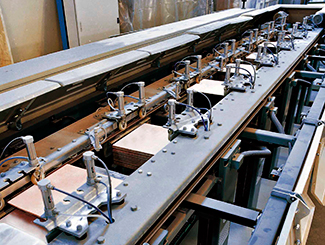 di Alfredo Ballarini15
Dicembre
2017
di Alfredo Ballarini15
Dicembre
2017
Industry 4.0 on companies financial statements
The group of companies operating in plant design and installation for the production of ceramic tiles, observed through a representative homogeneous sample of 93 firms during the three years considered, increased its sales in 2016 by +5.72% (+8.67% durin the previous two years) and its turnover from €2612 to €2761 million.
EBITDA has recovered, increasing from 7.95% to 8.54% after slightly decreasing in the two previous years. Value added almost remains unvaried in percentages on produced value, while the cost of labour and other operating expenses are decreasing, therefore improving EBITDA. Amortisation and provisions are on the increase too. But Ebit still manages to increase even if only slightly: from 4.66% to 4.97% on value of production. Financial income is increasing while at the same time taxes and extraordinary expenses are decreasing; hence the final profit in the profit and loss account reaches a respectable 3.54% of produced value. As we have already observed in the past, the income level isn't as high as one would expect from an industry which especially mirrors the innovation and technical skills of Italian entrepreneurs. Value added is certainly limited by outwork, a fundamental part in plant desing and installation, but it probably doesn't get sufficient promotion in the following step, when being launched on the market. Low profits could partly be due to the need of increasing inner efficiency since in such a complex activity any mistake or delay immediately turns into a lower performance.
The Net Financial Position decreases its impact on turnover down to 12.2% , a perfect manageable level, which can be brought to zero within 2.1 years despite operating cash flow remaining unvaried. Nevertheless the financial cycle remains negative: days payable outstanding are 108 while days sales outstanding are 125. Statistically, 2014 forecast on profit indicated that EBITDA would remain between 7.6% and 8% the following year, which it did. 2015 forecast indicated that in 2016 Ebitda would increase, and again it did. 2016 forecasts seem to indicate that Ebitda will again decrease in 2017, considering that there is a 52% chance that gross margin will fall below 8.2%, and a 46% that it should stay between 8.8% and 8.2%.
Switching to a graphical analysis of data, carried out through the new WI-FROM.exe app developed by us to automatically analyse in just one minute any year end financial statement previously filed in Italy, we can quickly trace a series of pictures from which to draw a rapid and overall assessment. The chart illustrating the financial structure performance enables a better evaluation of the company efficiency and the stability of assets and liabilities. It highlights how sales of the examined sector, represented by the triangle on the right, are lower than invested assets, corresponding to the whole rectangular area on the left; therefore the company efficiency as to the investment carried out by the industry's shareholders is less than 1, meaning that the industry's earnings are lower than investments. The matter is not without importance: starting from the assumption that businesses are first and foremost a form of investment from which some profit is expected, income results,because of the efficiency lower than 1, are reduced in percentages if related to invested capital. Net financial debts, shown in the oval area, are extremely lower than sales and invested capital. The industry's net working capital is definitely in the black, i.e. the green rectangle on the right is higher than the green rectangle on the left, indicating balanced debt deadlines (medium and long-term debts are higher than medium and long-term investments). Such a balance is being strengthened by positive current liabilities: i.e. liquidity is higher than short term financial debts as it emerges from the larger area of the red rectangle on the left compared to the one on the right in the chart. The picture emerging at a glance also from the subsequent chart: “Does it pay? Is there financial stability?" whose "cake" is divided into a red area (4%), representing the factors to improve, and into a green one (96%), which on the other hand highlights what has been achieved, is one of total serenity. The final chart “How does it economically work?” shows that the "to-improve" red area takes up 19-20% of the total cake (still less than the previous year), while the green one (the positive things accomplished) extends for a good 80%, therefore indicating a certainly positive situation.
Ideally summarizing the industry's economic and financial features through a unified rating process, examined through the S&P index but according to the author's personal methods, we would still confirm an AA+ rating.